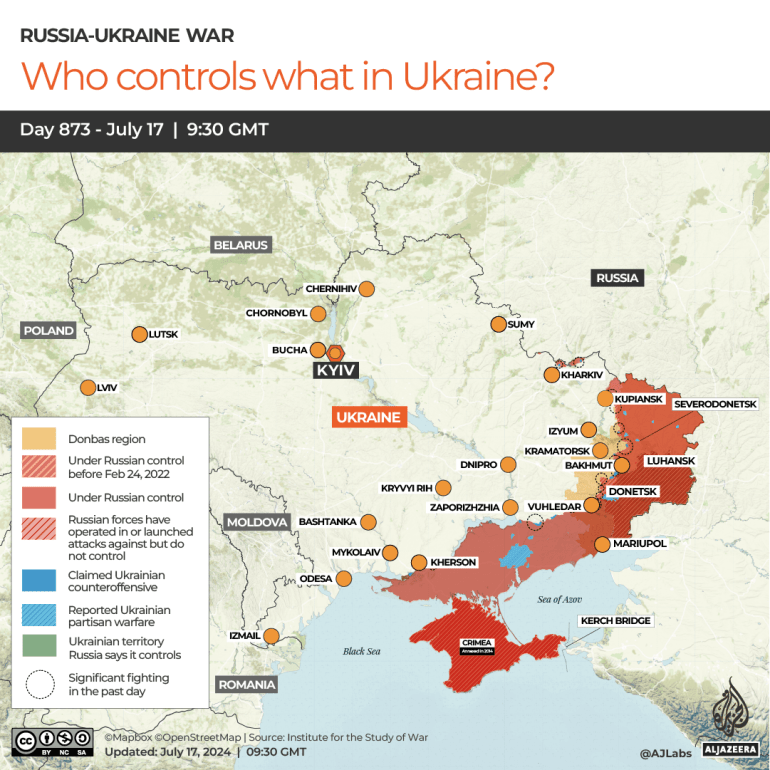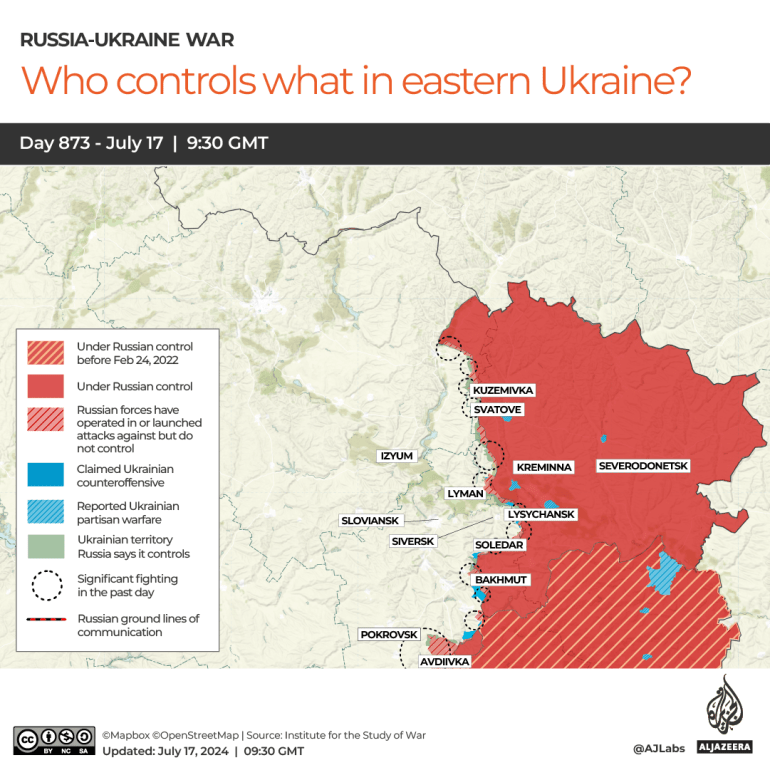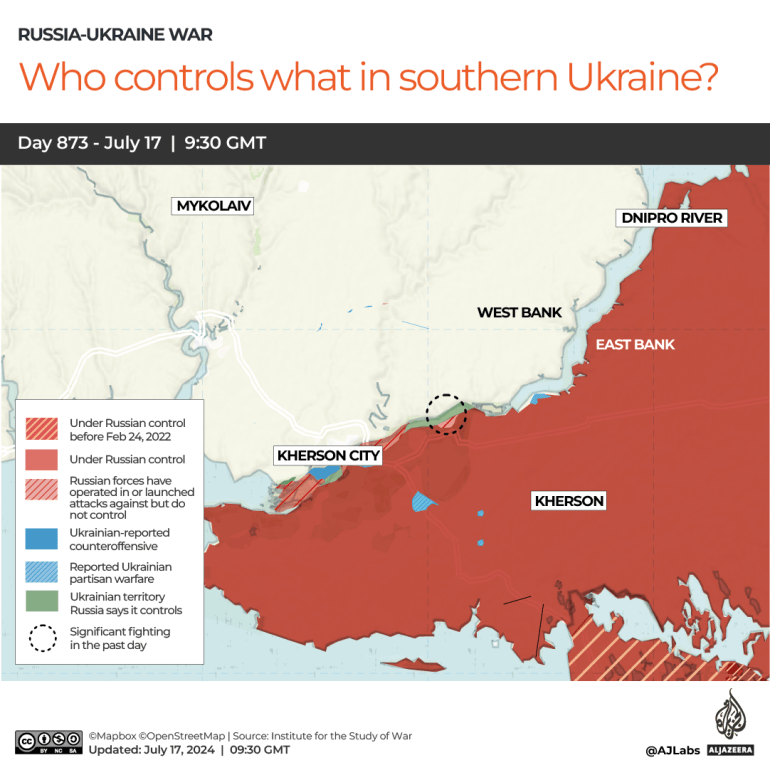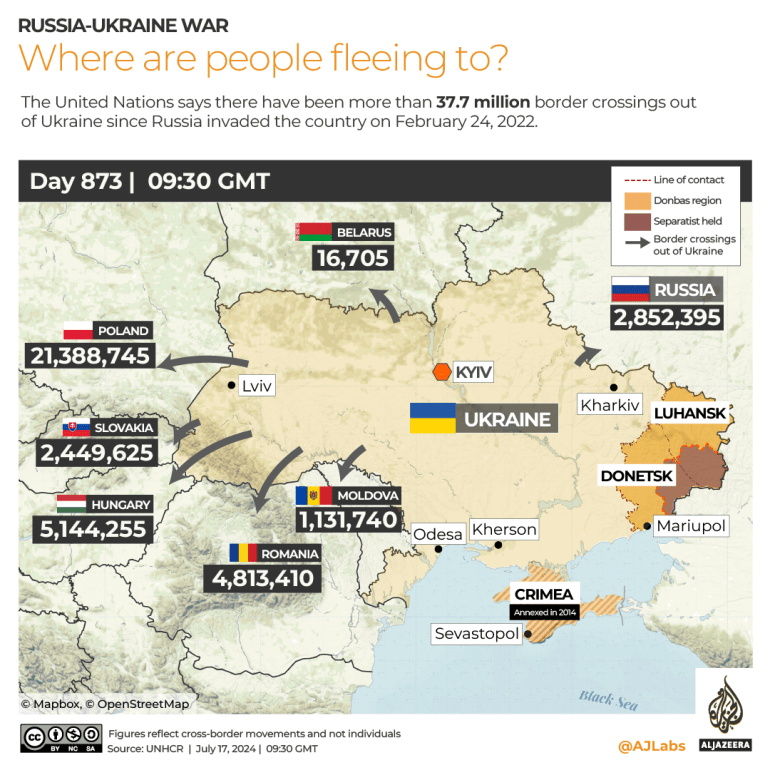A war of words over Ukraine took centre-stage in the past week, as the European Union sought to bolster its defence readiness, NATO celebrated its 75th birthday and Russia issued threats and promises.
European Commission President Ursula von der Leyen told the European Parliament she would pursue a defence union if re-elected for another five years, which she ultimately was.
“We will propose a number of Defence Projects of Common European Interest starting with a European Air Shield and cyber-defence,” she said on Thursday, triggering warning shots from Russia a day later.
Von der Leyen’s single market commissioner, Thierry Breton, earlier this year promised a 100-billion-euro ($109bn) investment fund for European defence industries. It has yet to materialise, but von der Leyen promised to create a dedicated defence portfolio and to pursue innovation and investment.
“It is astonishing. The European Union, which was created to ensure the wellbeing and stability of all its members, has now evolved into a NATO appendage,” said Russian Foreign Minister Sergey Lavrov at the UN a day earlier. “And [now the EU] is no less aggressively and, perhaps, sometimes even more aggressively demanding to inflict a defeat on Russia. What kind of strategic or any other dialogue could there be?” he asked.
Lavrov was explaining to reporters why Russia refused to attend a Ukrainian-organised peace summit in Switzerland last month, and so far refuses to attend three more mini-summits Ukraine plans – one on energy in Qatar by early August, one on freedom of navigation in Turkey next month, and one on prisoner of war exchanges in Canada in September. All three are to contribute to a second peace summit in November.

Ukraine has been stealthily building an international consensus on piecemeal aspects of a final peace deal with Russia.
On July 11, the General Assembly voted 99-to-9 in favour of a motion calling on Russia to unilaterally end its war of aggression and withdraw its soldiers from Ukrainian territory – releasing the Zaporizhzhia nuclear power station from its grasp.
A year into the war, 141 nations backed a similar call. In September 2022, 143 nations condemned Russia’s formal annexation of four Ukrainian regions.
Russia blames NATO for its aggression. Deputy head of the Russian Security Council Dmitry Medvedev said in an interview on Wednesday that “Ukraine’s admission [to NATO] … in essence is a declaration of war, albeit a deferred one.”
Moscow has demanded onerous conditions for talks – recognition by Ukraine of Russia’s annexation of the four regions it partly occupies, curtailment of its defence forces and refusal to join NATO.
Medvedev said a week earlier that “even this will not be the end of Russia’s military operation”, because “even after signing the papers and accepting the defeat, the rest of the radicals will sooner or later return to power, inspired by Russia’s Western enemies. And then it will be time to finally crush the viper.”
In fact, he seemed to prepare Russians for perennial war, saying there would be “future battles to defend the Fatherland.”
In Wednesday’s interview, he responded to NATO chief Jens Stoltenberg’s hope that Ukraine may join the alliance in a decade saying that by then, “it’s quite possible that… [Ukraine] will no longer exist.”

NATO reflected on none of this during celebrations of its 75th anniversary in Washington last week.
Italy, Germany and Romania pledged five additional Patriot air defence systems to Ukraine, and the US, Netherlands and Denmark promised that “Ukraine will be flying operational F-16s this summer.”
Denmark, Norway and the Netherlands have promised to deliver 60 decommissioned aircraft to Ukraine this year. Greece is conditionally offering another 32.
‘Russians shoot more often, but the results are better with us’
This war of words took place against a backdrop of incremental Russian advances in the Donetsk region.
Between July 9 and July 12, Russian troops completed the conquest of Kanal Microraion, the eastern extremity of Chasiv Yar, which has been particularly fiercely fought over. The reason is that Chasiv Yar is key to advancing against the last remaining bastions of Ukrainian defence in western Donetsk – the cities of Konstiantynivka, Kramatorsk and Sloviansk.
To capture Kanal Microraion, an area three blocks wide and three blocks deep, Ukrainian Deputy Defence Minister Ivan Havrylyuk said Russian forces suffered 5,000 casualties.
Their task now becomes harder, because the rest of Chasiv Yar lies on elevated ground and across a canal.
Russian forces have proven in the past that they are capable of capturing even strongly defended positions, notably at Bakhmut and Severdonetsk, but only after suffering very high loss of life and equipment.
“In June, the Russian army lost more than 1,400 artillery systems, more than 600 armoured fighting vehicles, almost 360 tanks. These are unprecedented losses. And what are the achievements on the battlefield?” wrote Deputy Defence Minister Ivan Havrylyuk in a July 9 article.
“These figures are evidence of the fact that we are winning the counter-battery struggle … Russians shoot more often, but the results are better with us.”

Russian forces also advanced northwest of Avdiivka, a city they captured in February, and in the direction of Toretsk. Along with Chasiv Yar, these three fronts lie within 40km (25 miles) of each other, and form the main thrust of Russian advance in Ukraine.
Elsewhere on the thousand-kilometre front, the Russians were stalemated, but that does not mean they didn’t suffer heavy losses.
Kharkiv, a front they opened in May likely to drain Ukrainian forces away from Chasiv Yar, has ended up draining Russian reserves.
Viktor Solimchuk, commander of the tactical group “Kharkiv” defending the area, told reporters that Russian casualties since May amounted to 2,939 killed and 6,509 wounded.
“That is, the estimated losses of the enemy in our direction are about 91 percent,” Solimchuk said.
Al Jazeera could not independently verify the toll.
The Kharkiv tactical group reported that Russia had transferred assault groups from its Pacific Fleet and the newly formed Leningrad Military District to sustain forces there.
Ukrainian military observer Colonel Konstantyn Mashovets said Russia’s units in central Donetsk needed similar reinforcement. A regiment from the 27th Motorised Rifle Division, which had been intended as a reserve division, had been deployed to Avdiivka before being staffed to full strength. Two other undermanned regiments were rushed to Toretsk.
Ukraine’s battlefield woes
Yet none of this meant that Ukraine was on the cusp of a breakthrough, either.
It plans to raise a quarter of a million new troops this year, but training and equipping them will take time. A senior NATO official told The New York Times that Ukraine would not be able to mount a large-scale counteroffensive until next year.
And Ukraine awaits a key decision on the part of Western governments supplying many of its weapons: to allow it to use them to attack inside Russia.
“It is more difficult and costly to shoot down enemy missiles in the air than to destroy [the aircraft that carry them] at airfields, missiles at arsenals, or target factories that produce deadly weapons,” wrote Havrylyuk.
Germany and the US have accompanied their weapons with restrictions on use inside Russia.
The United Kingdom, which had been thought to have imposed no such restrictions, may have done so as well, it was revealed in the past week, when incoming Foreign Secretary David Lammy told European Pravda he was “reflecting on” Ukrainian requests to hit airfields with British Storm Shadow missiles and had “undertaken to go away and look at some other things”.
